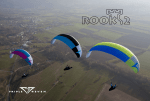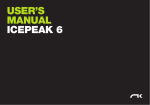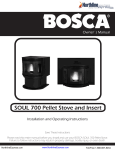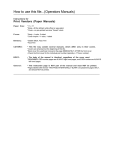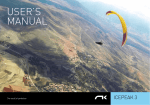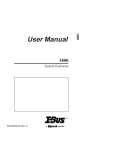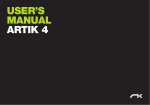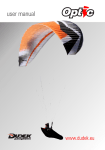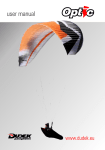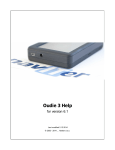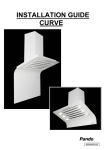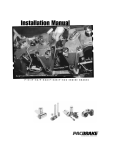Download USER`S MANUAL ICEPEAK 8
Transcript
USER’S MANUAL ICEPEAK 8 ICEPEAK 8 Changing the competition rules NIVIUK Gliders ICEPEAK 8. WELCOME This manual offers all the necessary information that will familiarize you with the main characteristics of your new paraglider. Although this manual informs you about your glider, it does not offer the instruction requirements necessary for you to be able to pilot this type of wing. Flying instruction can only be set by the competent organism in your country of flying zone. We wish to welcome you to our team and thank you for the confidence that you have placed in a NIVIUK Glider. We would like to share with you the commitment, the passion and emotions of the Niviuk design team, which have resulted in the creation of the new ICEPEAK 8. Niviuk are very proud of this new glider, a glider carefully designed to bring you maximum pleasure whilst allowing you learn and progress. The ICEPEAK 8 is the answer: a top competition glider designed and made for the most demanding pilots. The result is a wing comprised of more than two thousand parts to create a unique composition. We are confident that you will enjoy flying this wing and that you will soon understand the meaning of our slogan: “The importance of small details” This is the user’s manual that we recommend you to read in detail. The NIVIUK Gliders Team. NIVIUK GLIDERS C/ DEL TER 6, NAVE D 17165 LA CELLERA DE TER - GIRONA - SPAIN TEL. +34 972 42 28 78 FAX +34 972 42 00 86 [email protected] www.niviuk.com 2 USER’S MANUAL Nevertheless we remind you that it is important that you carefully read all the contents of the manual for your new ICEPEAK 8. Severe injuries to the pilot and passenger, including death, can be the consequence of the misuse of this equipment. Neither the manufacturer nor the dealers or sellers of this product are responsible of the damage derived from using this glider inappropriate way. Only the pilot is entirely accountable for any damage derived there from. SUMMARY WELCOME2 5.3 B-LINE STALL 12 USER’S MANUAL 2 5.4 SPIRAL DIVE 12 1. CHARACTERISTICS 4 5.5 SLOW DESCENT TECHNIQUE 12 1.1 WHO IS IT DESIGNED FOR? 4 6. SPECIAL METHODS 13 1.2 CERTIFICATION 4 6.1 TOWING 13 1.3 IN-FLIGHT BEHAVIOUR 4 6.2 ACROBATIC FLIGHT 13 1.4 ASSEMBLY, MATERIALS 5 7. FOLDING INSTRUCTIONS 13 1.5 ELEMENTS, COMPONENTS 5 8. CARE AND MAINTENANCE 13 2. UNPACKING AND ASSEMBLY 6 8.1 MAINTENANCE 13 2.1 CHOOSE THE RIGHT PLACE 6 8.2 STORAGE 13 2.2 PROCEDURE 6 8.3 CHECKS AND CONTROLS 14 2.3 ASSEMBLY OF THE HARNESS 6 8.4 REPAIRS 14 2.4 TYPE OF HARNESS 6 8.5 LINE REPLACEMENT 14 2.5 ASSEMBLY OF THE ACCELERATOR 6 9. SAFETY AND RESPONSIBILITY 15 10. GUARANTEE 15 2.6 INSPECTION AND WING INFLATION ON THE GROUND 7 11. TECHNICAL DATA 16 2.7 ADJUSTING THE BRAKES 7 11.1 GENERAL TECHNICAL DATA 16 3. THE FIRST FLIGHT 7 11.2 TECHNICAL DATA: CIVL 3.1 CHOOSE THE RIGHT PLACE 7 COMPETITION CLASS (CCC) 3.2 PREPARATION 7 11.3 SUSPENSION LINES TECHNICAL DATA 17 3.3 FLIGHT PLAN 7 11.4 LINE PLAN 18 3.4 PRE-FLIGHT CHECK LIST 7 11.5 SUSPENSION LINES 22 19 11.6 SUSPENSION LINES 24 20 3.5 WING INFLATION, CONTROL, 16 AND TAKE-OFF 8 11.7 SUSPENSION LINES 26 21 3.6 LANDING 8 11.8 FOLDING LINES PLAN 22 4. IN FLIGHT 8 11.9 OVERALL LENGHT 23 4.1 FLYING IN TURBULENCE 8 11.10 RISER ARRANGEMENT 27 4.2 POSSIBLE CONFIGURATIONS 8 11.11 ATTACHMENT POINTS POSITION 28 4.3 USING THE ACCELERATOR 10 11.12 TENSION BANDS 29 4.4 FLYING WITHOUT BRAKE LINES 10 11.13 MINIRIBS 30 4.5 KNOTS IN FLIGHT 10 11.14 DIAGONALS 31 5. LOSING HEIGHT 11 11.15 INLET SHAPE 32 5.1 EARS 11 12. CERTIFICATION 33 5.2 4C3 TECHNIQUE 11 3 1. CHARACTERISTICS 1.1 WHO IS IT DESIGNED FOR? The ICEPEAK 8 has been designed for experienced pilots and those wishing to compete in high performance competitions. It has been conceived for competition; therefore, it is able to fly kilometre after kilometre with an intensive pace. Its strengths are its glide, its excellent rapid ascent in thermals and its speed when flying. Moreover, it provides to the pilot a perfect transmission of the air flow and an incomparable security sensation in its category. Description of flight characteristics on CCC class: Paragliders with very demanding flying characteristics and potentially violent reactions to turbulence and pilot errors. Recommended for experienced and regularly flying pilots. The intervention of the pilot is needed to recover a normal flight state. Description of the skills and experience required for this glider: For those pilots used to recovery techniques, active piloting, to fly on turbulent conditions and capable of flying these kind of demanding gliders. Check the certification results and figures on the last pages of this manual or at www.niviuk.com 1.2 CERTIFICATION Designing a new high-featured and accessible glider is the result of years of research and extensive testing flights under all conditions and in different places in order to provide an easy piloting wing. The ICEPEAK 8 has successfully achieved the CIVL Competition Class (CCC).This test was carried out in the Swiss Air-Turquoise laboratories in Switzerland. All the commercially available sizes passed every required test with excellent results and the ICEPEAK 8 received CCC certification for all sizes. The ICEPEAK 8 passed the essential load test of 8g without experiencing any problems. We recommend paying special attention on the flight test report made by the certification laboratory, and specially attention to the test pilot comments. On the flight test report there is all necessary information to know how the 4 new paraglider will react on each manoeuvre tested. It is important to take into account that each size can have a different reaction on the same manoeuvre. Furthermore, the same size on maximum load or minimum load can experiment a different behaviour. 1.3 IN-FLIGHT BEHAVIOUR Its new profile makes the most of the airflow to maximize the efficiency of the glider. More compact and clean leading edge. New materials in the internal part of the glider to provide the endurance needed in competition and lightness. Excellent feeling on thermals, better climb rate and stall recovery. The outcome of putting all this technology together is a trusty and stable glider even at maximum speed. It is more demanding, but providing fantastic turning for a 2-liner glider and the same comfort that characterize all Icepeak models. With an aspect ratio of 7.6 it is a 2 liner wing that provides clear and useful information to the pilot; it usually situates itself into the center of the thermal or it follows the ascendant (good) air flow. While flying the ICEPEAK 8 the pilot feels that can reach his full potential. In thermals, you will realize that you are piloting a glider with a big capacity to reach the nucleus. Regarding speed and L/D, ICEPEAK 8 is surprising; the pilot can feel the glider, through the accelerator pulley, and can anticipate its movements. Even at high speed the wing is stable. The accelerator pulley of ICEPEAK 8 works gradually and lets you enjoy real acceleration without losing L/D in the first part of the accelerator. The wing is homogeneous, fast and capable to fly as far as you dreamed possible. The second part of the accelerator is very accessible and pleasure to use. The glider keeps its excellent glide angle throughout a full days flying in all conditions. If you already are a Niviuk pilot the improvements of this glider will surprise you. If this is the first time you pilot one of our gliders, just enjoy it! 1.4 ASSEMBLY, MATERIALS The ICEPEAK 8 has all the technological innovations as used on other Niviuk gliders. Furthermore it is full of small details destined to enhance the pilots’ comfort and to improve the performance. The new generation profile of the ICEPEAK 8 has been conceived to efficiently distribute the total load across the two rows of lines. The chosen materials and line dimensions have minimum air resistance while respecting the security and maximum load efficiency. The fabrics used in the construction of the ICEPEAK 8 have been carefully selected for their lightweight, uv standards and resilient properties when used during normal conditions. Not a single millimetre of error is possible in the manufacturing process from Olivier’s computer to the cutting of the fabric. An automatic process controlled by a laser-cutting program cuts each of the sections that compose the different parts of the wing. This program not only cuts the pieces of fabric but it also paints the guideline marks that will aid the assembly; it also numbers the separate pieces of material. All this is carried out before human handling of the pieces begins. So we eliminate possible and understandable errors that may occur during this delicate procedure. The lines are semi-automatically manufactured and all the sewing is finished under the supervision of our specialists. The jigsaw puzzle of the assembly process is made easier using this method. We minimize the processes while making the quality control more efficient. All the different parts of the canopy are cut and assembled under the strict conditions induced by the automation of the whole process. It is strongly recommended that all lines are thoroughly checked by the pilot prior to every flight and ultimately checked by a service centre or Niviuk dealer after the first 30 hours of flight. We should not forget that we are using materials with great performance but that they need a rigorous check before every flight. All NIVIUK Gliders go through an extremely thorough and efficient final inspection. Every single line of each glider is measured individually once the final assembly has concluded. Each wing is then individually inflated for the last visual revision. Each glider is packaged following the maintenance and conservation instructions recommended for the advanced materials. NIVIUK Gliders are made of first class materials as demanded by the performance, durability, and homologation requirements of the present-day market. Information about construction materials is given on the last pages of this manual. 1.5 ELEMENTS, COMPONENTS The ICEPEAK 8 is delivered to its owner together with a series of 5 components that, although not fundamental, do take an important part in the use, transport and storage of the paraglider: The new large capacity Kargo rucksack, ideal for packing also one competition harness (such as the Drifter). Capacity and comfort all in one. it. Check the condition of the fabric and the lines, making sure there are no abnormalities. Check the maillons, which attach the lines to the risers, are properly closed. Identify and if necessary disentangle the lines from A and A’ and B risers, the brake lines and the corresponding risers. Make sure that there are no ties or knots. 2.3 ASSEMBLY OF THE HARNESS The N-Kare bag which makes easy the glider folding process. Moreover, it protects the wing when packing and carrying. An adjustable strap for quick and easy compression to fold the wing as small as possible A small fabric repair including auto adhesive rips top (same colours of the wing) and replacement maillon blockers. The user’s manual with the answers all our questions about our new ICEPEAK 8 is available at www.niviuk.com 2.UNPACKING AND ASSEMBLY 2.4 TYPE OF HARNESS The ICEPEAK 8 has been certified on CCC which allows it to be flown with most of the harnesses on the market, even the ones that use cocoon. We strongly recommend that you adjust the distance of the chest strap according the values used during certification. This varies according to the size of the chosen harness. 2.1 CHOOSE THE RIGHT PLACE Wide 41cm/Height 46cm We recommend that you unpack and assemble your wing on a schooling slope or a flat clear area without too much wind and free of obstacles. These conditions will allow you to carry out all the steps required for you to check and inflate the ICEPEAK 8. Incorrect adjustment can seriously affect the piloting of the glider. A distance, which is too wide between the karabiners, may provide more feedback but could affect the overall stability of the glider. A distance, which is too narrow between the karabiners, would provide less feedback but also increase any risk of developing a twist in during a large collapse. We recommend that an instructor or a retailer supervises the entire procedure as only they are competent to resolve any doubt in a safe and professional way. 2.2 PROCEDURE Take the paraglider out of the rucksack, open it and spread it open with the lines on top of the underside, position the wing as if you were to inflate 6 Correctly place the risers on the harness karabiners. The risers and lines should not have any twists and they should be in the right order. Check that the harness buckles are correctly locked. Any change made to these specifications may affect the wing’s performance and reactions. This would therefore effect the glider’s configuration and would not conform to the homologation. 2.5 ASSEMBLY OF THE ACCELERATOR The acceleration mechanism of the ICEPEAK 8 works when you push with your feet on the accelerator bar, this is supplied with the equipment. On delivery the accelerator bar has not yet been installed and it is recommended that it is fit by yourself before flight. Most harnesses are equipped with a pre-installed acceleration system. When fitting any accelerator system ensure that all preinstalled items within the harness, such as roller pulleys are used correctly. After fitting, take into account that you will have to adjust the length of the accelerator lines for correct use. This will vary according to the length of the pilot’s legs! We recommend that you try the correct fitting of the acceleration system on equipment designed to do this, most paragliding schools have this sort of equipment. 2.6 INSPECTION AND WING INFLATION ON THE GROUND Once you have checked all the equipment and made sure that the wind conditions are favourable, inflate your ICEPEAK 8 as many times as necessary in order to become acquainted with the wing’s behaviour. The ICEPEAK 8 inflates easily and smoothly. An excess of energy is not necessary and the wing will inflate with minimum pressure on the harness when you move forward. This may be assisted by using the A lines. Do not pull on them; just accompany the natural rising movement of the wing. Once the wing is in the 12 o’clock position, simply apply correct pressure on the brake lines and the ICEPEAK 8 will sit over your head. become accustomed to the ICEPEAK 8 and its unique flying behaviour. If you then decide to change the length of the brake lines, untie the knot, slide the line through the brake link to the desired length, and strongly re-tie the knot. Qualified personnel should carry out this adjustment. You must ensure that this adjustment does not slow down the glider without any pilot input. Both brake lines should be symmetrical and measure the same length. The most recommended knots are the clove hitch knot or bowline knot. When changing the brakes length, it is necessary to check that they do not act when the accelerator is used. When we accelerate the glider rotates over the B riser and the trailing edge elevates. We must check that the brake is adjusted taking in consideration this extra length in acceleration. 3. THE FIRST FLIGHT 3.1 CHOOSE THE RIGHT PLACE We recommend that the first flight with your ICEPEAK 8 is made on a smooth slope (a school slope) or in your usual flying area. 3.2 PREPARATION Repeat the procedures detailed in chapter 2 UNPACKING AND ASSEMBLY in order to prepare your equipment. 3.3 FLIGHT PLAN 2.7 ADJUSTING THE BRAKES Draw out a flight plan before take-off in order to avoid possible flight errors. The length of the main brake lines is adjusted at the factory to the length established during certification. However, the length can be changed to adapt to the pilots’ flying style. Nevertheless, we recommend that you fly for a while with these, set at the original length. This will allow you to 3.4 PRE-FLIGHT CHECK LIST Once you are ready, but before you take-off, carry out another 7 equipment inspection. Ensure correct installation of all equipment and that all lines are free of hindrances or knots. Check that the weather conditions are suited for your flying skills. 3.5 WING INFLATION, CONTROL, AND TAKE-OFF Smoothly and progressively inflate the wing (chapter 2.6 INSPECTION AND WING INFLATION ON THE GROUND). The ICEPEAK 8 inflates easily and does not require excessive energy. It does not tend to over-take you, so the wing inflation phase is carried out without anguish. These take off characteristics provide a perfect control phase and enough time for the pilot to decide whether to accelerate and take off. Whenever the wind speed allows it, we recommend a reverse launch technique; this type of launch allows you to carry out a better visual check of the wing. The ICEPEAK 8 is especially easy to control in this position in strong winds. However, wind speeds up to 25 to 30 km/h are considered strong and extra consideration should be given to any thought of flight. 4. IN FLIGHT 4.1 FLYING IN TURBULENCE The ICEPEAK 8 has an excellent profile to withstand the very different aero-logical conditions so allowing the best possible piloting and stability. It reacts admirably in passive flight, thus offering a high level of safety in turbulent conditions. Nonetheless, the pilot always has to pilot according to the prevailing weather conditions, the pilot is the ultimate safety factor. We recommend active piloting, making the necessary fine adjustments to keep the wing in control. He/she should stop braking to allow it to fly at the required wing speed after a correction is made. Do not maintain any correction for longer than necessary (braked) this would cause the wing to enter into critical flying situation. Whenever necessary, control a situation, react to it and then re-establish the required speed. 4.2 P OSSIBLE CONFIGURATIONS Preparation and positioning of the wing on the take-off is especially important. Choose a location which is appropriate for the direction of the wind. Position the paraglider as if it were part of a large circle, taking into account the shape of the canopy in flight. All this will assist in a trouble free take-off. 3.6 LANDING The ICEPEAK 8 lands excellently, it transforms the wing speed into lift on the pilot’s demand, allowing an enormous margin of error. You will not have to wrap the brake lines around your hand to get greater braking efficiency. 8 We recommend that training to master these manoeuvres be carried out under the supervision of a competent school. Asymmetric collapse In spite of the stability of the profile of the ICEPEAK 8, heavy turbulent conditions may cause part of the wing to collapse asymmetrically. This usually happens when the pilot has not foreseen this possible reaction of the wing. When the wing is about to experience an asymmetric collapse the brake lines and the harness will transmit a loss of pressure to the pilot. To prevent the collapse from happening, pull the brake line corresponding to the compromised side of the wing, this will increase the angle of incidence. If the collapse does happen the ICEPEAK 8 will not react violently, the turn tendency is very gradual and it is easily controlled. Lean your body towards the side that is still flying in order to counteract the turn and to maintain a straight course, if necessary slightly slow down the same side. The collapse will normally open by itself but if that does not happen, pull completely on the brake line on the side, which has collapsed (100%). Do this with a firm movement. You may have to repeat this operation to provoke the re-opening. Take care not to over-brake on the side that is still flying (turn control) and when the collapse has been solved; remember to let the wing recover its flying speed. Symmetric collapse In normal flying conditions the design of the ICEPEAK 8 ensures that a symmetric collapse is quite improbable. The profile of the wing has been designed to widely tolerate extreme changes in the angle of incidence. A symmetric collapse may occur in heavy turbulent conditions, on entry or exit of strong thermals or lack of adapting the use of the accelerator to the prevailing air conditions. Symmetrical collapses usually re-inflate without the glider turning but you can symmetrically apply the brake lines with a quick deep pump to quicken the re-inflation. Release the brake lines immediately to recover optimum flight speed. Negative spin This configuration is out of the normal flight behaviour of the ICEPEAK 8. Certain circumstances however, may provoke this configuration such as trying to turn when the wing is flying at very low speed (while heavily braking). It is not easy to give any recommendations about this situation since it varies depending on the circumstances. Remember that you should restore the relative air speed over the wing. To achieve this, progressively reduce the pressure on the brake lines and let the wing gain speed. The normal reaction would be a lateral surge with a turn tendency no greater than 360º before restoring to normal flight conditions. Parachutal stall If it does happen, the feeling would be that the wing would not be advancing; you would feel a kind of instability and a lack of pressure on the brake lines, although the canopy would appear to be correctly inflated. The correct reaction would be to release the pressure on the brake lines and push the A lines forward or rather lean your body to any side WITHOUT PULLING ON THE BRAKE LINES. Deep stall The possibility of the ICEPEAK 8 falling into this configuration during normal flight is very unlikely. This could happen if you are flying at a very low speed, whilst over steering in a number of manoeuvres and in turbulent conditions. To provoke a deep stall you have to take the wing to minimum flight speed by symmetrically pulling the brake lines, when you reach this point, continue pulling until you reach 100% and then hold. The glider will first fall behind you and then situate itself above you, rocking slightly, depending on how the manoeuvre was carried out. When you start to provoke a stall, be positive and do not doubt an instant. Do not release the brake lines when half way through the manoeuvre. This would cause the glider to surge violently forward with great energy and may result in the wing below the pilot. It is very important that the pressure on the brake lines is maintained until the wing is well established vertical above. To regain normal flight conditions, progressively and symmetrically release the brake lines, letting the speed be re-established. When the wing reaches the maximum advanced position ensure that the brakes are fully released. The wing will now surge forward, this is necessary so that air speed is completely restored over the wing. Do not over brake at this point because the wing needs to recover speed to quit the stall configuration. If you have to control a possible symmetrical front stall, briefly and symmetrically pull on the brake lines and let go even when the wing is still ahead of you. Wing tangle A wing tangle may happen after an asymmetric collapse, the end of the wing is trapped between the lines (Cravat). This situation could rapidly cause the wing to turn, although it depends on the nature of the tangle. The correction manoeuvres are the same as those applied in the case of an asymmetrical collapse, control the turn tendency by applying the 9 opposite brake and lean your body against the turn. Then locate the line that reaches the stabiliser that is trapped between the other lines. This line has a different colour and belongs to the external lines of the A’ riser. Pull on this line until it is tense, this should help to undo the wing tangle. If you cannot undo the tangle, fly to the nearest possible landing spot, control the flying course with your body movements and a little pressure on the opposite brake. Be careful when attempting to undo a tangle if you are flying near a mountainside or near to other paragliders, you may lose control of the flying course and a collision may occur. movements and pressure on the accelerator whilst constantly adjusting the pressure applied to the brake lines. This balance is considered to be “active piloting.” Over handling Most flying incidents are caused by incorrect actions of the pilot, which chained one after another creates abnormal flying configurations (a cascade of incidents). You must remember that over handling the wing will lead to critical levels of functioning. The ICEPEAK 8 is designed always to try to recover normal flight by itself, do not try to over handle it. The ICEPEAK 8 is a new generation 2 liner CCC class glider which allows piloting with the back risers. The back risers of the ICEPEAK 8 have handles conceived to do that. Generally speaking, the reactions of the wing, which follow over handling, are neither due to the input made or the intensity, but the length of time the pilot continues to over handle. You have to allow the profile to reestablish normal flight speed after any type of handling. 4.3 USING THE ACCELERATOR The profile of the ICEPEAK 8 has been designed to fly stable through its entire speed range. It is useful to accelerate when flying in strong winds or in extreme descending air. When you accelerate the wing, the profile becomes more sensitive to possible turbulence and closer to a possible frontal collapse. If you feel a pressure loss, you should release the pressure on the accelerator and pull slightly on the brake lines to increase the angle of incidence. Remember that you have to re-establish the flight speed after correcting the incidence. It is NOT recommended to accelerate near to the mountainside or in very turbulent conditions. If necessary you will have to constantly adjust the 10 The ICEPEAK 8 risers have been designed with built-in non adjustable, removable or variable “limiters” to prevent an incorrect use of the accelerator system. 4.4 FLYING WITHOUT BRAKE LINES The ICEPEAK 8 allows the classical piloting using only the breaks. However, piloting using the back risers is now a common technique that allows reaching more control and precision over the wing while keeping the glider accelerated without utilizing the breaks. 4.5 KNOTS IN FLIGHT The best way to avoid these knots and tangles is to inspect the lines before you inflate the wing for take-off. If you notice a knot before takeoff, immediately stop running and do not take-off. If you have taken-off with a knot you will have to correct the drift by leaning on the opposite side of the knot and apply the brake line on that side too. You can gently try to pull on the brake line to see if the knot becomes unfastened or try to identify the line with the knot in it. Try to pull the identified line to see if the knot undoes. Be very careful when trying to remove a knot. When there are knots in the lines or when they are tangled, do not pull too hard on the brake lines because there is an increased risk of the wing to stalling or negative turn being initiated. Before trying to remove a knot, make sure there are no pilots flying nearby and never try these manoeuvres near the mountainside. If the knot is too tight and you cannot remove it, carefully and safely fly to the nearest landing place. 5. LOSING HEIGHT The knowledge of the different descent techniques is an important resource to use in certain situations. The most adequate descent method will depend on the particular situation. We recommend that you learn to use these manoeuvres under the tuition of a competent school. 5.1 EARS Big ears is a moderate descent technique, achieving about –3 or –4 m/s and a reduction in ground speed of between 3 and 5 km/h. Effective piloting then becomes limited. The angle of incidence and the surface wing load also increases. Push on the accelerator to restore the wing’s horizontal speed and the angle of incidence. To activate big ears take the line on each A’ risers and simultaneously, smoothly pull them outward and downward. The wingtips will fold in. Let go of the lines and the big ears will re-inflate automatically. If they do not re-inflate, gently pull on one of the brake lines and then on the opposite one. We recommend that you re-inflate asymmetrically, not to alter the angle of incidence, more so if you are flying near the ground or flying in turbulence. to apply brake pressure without realising it. The same happens whilst pulling down the 4a3 line to make the ears. This can obviously lead to a significant speed decrease. The ICEPEAK 8 has a new high arch concept and applying ears induces more resistance. With this new arch, the ears don’t stick but they do tend to “hang”. Because of this, there will be more resistance, compared to ears on a standard glider. The ICEPEAK 8 is designed with little cord, which is good innormal flight conditions.However, on the other hand the glider could get into trouble when recovering normal speed if it is allowed ears and achieve an extreme angle of incidence. These are 3 particularities, which together with turbulent conditions could cause an unintentional stall. The solution: big ears may still be applied but the pilot must be fully aware of the above-mentioned points and act accordingly. To avoid the stall simply use the accelerator halfway (this is sufficient) to increase the speed, which naturally risers the speed and decreases the angle of incidence. In this way you will maintain a safe margin and avoid this phenomenon. Take care not to pull the brakes while making the ears!! 5.2 4C3 TECHNIQUE On the new generation paragliders the application of big ears can create a high degree of trailing turbulence which in turn creates a significant loss of airspeed. When big ears are applied to high aspect ratio wings the ears tend to “flap” which also adds to the amount of unwanted turbulence. Please, read this carefully: risk of full stall!!! The ICEPEAK 8 has a relatively short brake travel and it should be noted that by reaching for the 4a3 line to make big ears it is possible This new rapid descent technique was first discovered by our Niviuk team Pilots in 2009 while flying a competition prototype wing, which because of its line plan and high aspect ratio would not allow big ears 11 to be applied. In fact big ears on wings with a profile of 2 lines can often prove difficult. For all these reasons, we advise the use of the 4C3descent technique on the ICEPEAK 8. This technique ensures a rapid descent is achieved whilst forward wing speed is maintained and so the risk of a deep stall is eliminated. HOW? Locate the 4C3on your risers and as you would when applying big ears simply pull down firmly and smoothly until you see both wingtips drop back slightly. The forward speed of the glider speed will then reduce slightly, quickly stabilize and then increase. You will then experience a fall rate of around 5-6m/s. Controlled turning of the wing can easily be maintained by weight shifting the harness, exactly the same as you would with big ears. We recommend the application of the speed bar whilst using this technique. To exit the maneuver release the lines as you would with big ears, control the pitch and the wing will quickly adopt normal flight. This new technique allows a comfortable and controllable rapid descent without the risk of experiencing a “cravat” or “deep stall”. We advise you to first try this technique in smooth conditions with sufficient altitude above appropriate terrain. kouts). These are the reasons why it is best to carry out this manoeuvre gradually so your capacity to resist the G forces increases and you will learn to fully appreciate and understand the manoeuvre. Always practice this manoeuvre when flying at high altitude. To start the manoeuvre, first lean your bodyweight and pull the brake line to the side to which you are leaning. You can regulate the intensity of the turn by applying a little outside brake. A paraglider flying at its maximum turn speed can reach –20 m/s, equivalent 70 km/h vertical speed and stabilize in a spiral dive from 15 m/s onwards. These are the reasons why you should be familiar with the manoeuvre and know how to carry out the exit methods. To exit this manoeuvre you must progressively release the inside brake and also momentarily apply outside brake. Whilst doing this you must also lean your bodyweight towards the outside. This exit manoeuvre has to be carried out gradually and with smooth movements so you can feel the pressure and speed changes at the same time. The after effect of the exit manoeuvre is that the glider will rock briefly with lateral surge, depending on how the manoeuvre has been carried out. Practice these movements at sufficient altitude and with moderation. 5.3 B-LINE STALL 5.5 S LOW DESCENT TECHNIQUE This manoeuvre is not possible with this wing. 5.4 SPIRAL DIVE This is a more effective way for rapidly losing height. You have to know that, the wing can gain a lot of vertical speed and rotation speed (G force). This can cause a loss of orientation and consciousness (blac12 Using this technique (do not hurry to descend) we will fly normally, without forcing neither the material nor the pilot. It means looking for descending air areas and turn as it was a thermal – in order to descend. We have to avoid danger areas when looking for descent zones. Safety is the most important thing. 6. SPECIAL METHODS 6.1 TOWING The ICEPEAK 8 does not experience any problem whilst being towed. Only qualified personnel should handle the qualified equipment to carry out this operation. The wing has to be inflated in the same way as in normal flight. neatly alongside each other. The wing should then be folded into three sections of equal width with each section stacked upon the other. In order to avoid placing undue stress on the internal structures when packed, it is important that each section is folded to the same length as the internal structure of the SLE. Several smaller folds should be avoided. 8. CARE AND MAINTENANCE 6.2 ACROBATIC FLIGHT 8.1 MAINTENANCE Although the ICEPEAK 8 has been tested by expert acrobatic pilots in extreme situations, it HAS NOT been designed for acrobatic flight and we DO NOT RECOMMEND THE USE OF THIS GLIDER for that use. We consider acrobatic flight to be any form of piloting that is different to normal flight. To learn safely how to master acrobatic manoeuvres you should attend lessons, which are carried out and supervised by a qualified instructor over water. Extreme manoeuvres take you and your wing to centrifugal forces that can reach 4 to 5g. Materials will wear more quickly than in normal flight. If you do practice extreme manoeuvres we recommend that you submit your wing to a line revision every six months. Careful maintenance of your equipment will ensure continued performance. The fabric and the lines do not need to be washed, if they become dirty, clean them with a soft damp cloth. If your wing gets wet with salty water, immerse it in fresh water and dry it away from direct sunlight. The sunlight may damage the materials of your wing and cause premature aging. Once you have landed, do not leave the wing in the sun, store it properly. If you use your wing in a sandy area, try to avoid the sand from entering through the cell openings of the leading edge. If sand is inside the wing, remove it before folding. 7. FOLDING INSTRUCTIONS In order to guarantee the correct preservation of the glider and to keep it in perfect flying condition, we recommend using always an appropriate folding method. Folding should be carried out cell to cell (accordion style) with the SLE ribs remaining parallel to the leading edge at all times. The same technique should then be applied to STE ribs on the trailing edge and when complete the cell structures along the entire chord of the wing should lay parallel and If it gets wet of sea water, you should submerge it into fresh water and let it dry far away from the sun. 8.2 STORAGE It is important that the wing is correctly folded when stored. Store your flying equipment in a cool, dry place away from solvents, fuels or oils. It is not advisable to store your flying equipment in the trunk of your car. Temperatures inside a car parked in the sunlight, can be very high. Inside 13 a rucksack and in the sunlight temperatures can reach 60ºC. Weight should not be laid on top of the equipment. If the flying gear is stored with organic material (such as leaves or insects) inside, the chemical reaction can cause irreparable damage. 8.3 CHECKS AND CONTROLS 8.4 REPAIRS We strongly recommend that all actions on the glider were advised for professionals. If the wing is damaged, you can temporarily repair it by using the rip stop found in the repair kit, so long as no stitches are involved in the tear. Any other type of tear must be repaired in a specialized repair shop or by qualified personnel. Do not accept a home repair. Always check all the flying equipment before every flight. 8.5 LINE REPLACEMENT In spite of providing much more benefits to the pilots, 2 liner gliders need more care and control of the calibration. The ICEPEAK 8 mechanic and UV resistance are one of the highest for this type of line. With a 2 liner glider every little variation on the calibration of the lines has a directly effect on the performance of the wing. The use of new high performance materials in modern wings is now a reality. The achievements made using these materials in terms of performance are widely accepted by all as part of the evolution of our sport. However, along with these advances in technology and achievements there are added responsibilities which cannot be avoided The revision and replacement of the lines must now be carried out on a more frequent basis and that increased frequency appears to be encouraging many pilots to try and replace the line set themselves. We recommend checking the lines calibration after the first 30 hours +/of flight. This examination must be taken apart from the regular checking every 100 hours of use or every two years (whichever happens first). Why is it necessary? 14 Only qualified professionals should realize it. Do not modify the wing considering the calibration required for other pilots before being sure that it is really necessary for us. WE STRONGLY RECOMMEND THAT ANY LINE REPLACEMENT IS ONLY CARRIED OUT BY AN AUTHORISED AND SPECIALISED PERSON. Thanks to the experience acquired with the 2 liner gliders on the previous seasons and to the incessant control task of our R&D team over the Abac Team gliders, we are capable now of predicting how to take appropriately care of this kind of lines to assure the best performance of the profile. Following the controls recommended the glider will keep its original features for longer. However that choice is ultimately the responsibility of the pilot and if the pilot chooses to carry out any line replacement themselves without guidance from a professional then we suggest the following guidelines are applied. The conditions of the flight zone, the climate area, temperature, humidity, wing load, …cause a different impact over the wing. That’s why the calibration would be set taking in consideration these factors. • That the line plan is correct • That the lines in the supplied set are present and correct. • Never assume, check every line individually. Before removing any lines, check: • After confirming all the lines are correct: Fit the new lines WITHOUT removing the label. • Once replaced measure the total line length. Inflate the wing ensuring perfect symmetry and ease of inflation checking for any abnormalities. The line labels may then be removed but NOT BEFORE. Niviuk strongly recommend that any line replacement is carried out only by an authorised professional and will not accept responsibility for any damage or injury caused as a result of incorrect re-assembly. 9.SAFETY AND RESPONSIBILITY It is well known that paragliding is considered a high-risk sport, where safety depends on the person who is practising it. Wrong use of this equipment may cause severe injuries to the pilot, even death. Manufacturers and dealers are not responsible for any act or accident that may be the result of practicing this sport. You must not use this equipment if you are not trained. Do not take advice or accept any informal training from anyone who is not properly qualified as a flight instructor. 10. GUARANTEE The entire equipment and components are covered by a 2-year guarantee against any manufacture fault. The guarantee does not cover misuse or abnormal use of the materials. 15 11. TECHNICAL DATA 11.2 TECHNICAL DATA: CIVL COMPETITION CLASS (CCC) 11.1 GENERAL TECHNICAL DATA ICEPEAK 8 CELLS FLAT 22 24 26 ICEPEAK 8 CCC NUMBER 99 99 99 FLAT CLOSED 14 14 BOX 27 LINES 25,5 14 SPAN M 12,73 13,18 13,6 27 27 ASPECT RATIO 7,28 7,28 7,28 24 25,5 SPAN M 13,08 13,51 13,92 7,6 7,6 7,6 19,31 20,6 21,89 SPAN 10,74 11,1 11,44 ASPECT RATIO 5,98 5,98 5,98 % 15 15 15 MAXIMUM M 2,13 2,2 2,27 MINIMUM M 0,48 0,5 0,51 AVERAGE M 1,72 1,78 1,83 TOTAL METERS M 220 227 235 HEIGHT M 8 8,26 8,52 230 230 230 AREA M2 MAIN 6 + BRAKE 2/1/3+B 2/1/3+B 2/1/3+B NUMBER 3 A/A'/B A/A'/B A/A'/B NO NO NO TRIMS ACCELERATOR M/M 120 120 130 TOTAL WEIGHT MINIMUM KG 80 95 105 IN FLIGHT MAXIMUM KG 100 115 125 KG 6 6,15 6,3 CCC CCC CCC GLIDER WEIGHT CERTIFICATION 16 24 22,5 NUMBER RISERS 26 22,5 M2 FLATTENING CORD 24 M2 AREA ASPECT RATIO PROJECTED 22 AREA CORD TRAILING EDGE/2 CORD A M 2,17 2,25 2,32 CORD B (RIB Nº21) M 1,92 1,99 2,06 M 6,49 6,69 6,88 Canopy measurements referenced to points 7.1 and 7.5 in CIVL Competiton Class (CCC), 2015 Edition, Revision 3.5. 11.3 SUSPENSION LINES TECHNICAL DATA ICEPEAK 8 MATERIAL CODE DC DC 16140 16330 12240 12470 12950 TNL STRENGTH CODE 040 060 70 145 115 200 405 280 DIAMETER m/m 0,5 0,6 0,7 1 0,9 1,2 1,6 1,8 CORE MATERIAL Ø DYNEEMA DYNEEMA VECTRAM VECTRAM VECTRAM VECTRAM VECTRAM TECHNORA SLEEVE MATERIAL NO NO POLYESTER WEIGHT G/M TOTAL 0,19 0,24 0,39 0,77 0,56 1,17 2 2,7 BREAKING STRENGTH MINIMUM 40 60 70 145 115 200 405 280 MAXIMUM 48 84 74 153 122 215 430 320 TEST EN 33 74 31 77,5 60,9 112,1 237,5 138,6 0,75 0,2 0,2 0,2 0,35 0,2 1 0,4 0,4 0,3 0,4 0,3 15 DAN EN % 1 0,7 0,4 0,4 0,5 0,4 20 DAN EN % 1,4 0,8 0,9 0,5 0,7 0,4 25 DAN EN % 1,75 0,9 1 0,6 0,9 0,5 2,75 1,5 1,6 1 1 0,9 75 DAN EN % 2 2 1,4 1,3 1,3 100 DAN EN % 2,4 3 1,7 1,7 1,7 125 DAN EN % 3 2,1 1,8 2 150 DAN EN % 3,6 2,4 1,9 2 175 DAN EN % 2,8 2 2,7 200 DAN EN % 3,2 2,4 2,8 STRENGTH AFTER 5.000 BENDING CYCLES ELONGATION AT 5 DAN EN % 10 DAN EN % 30 DAN EN % 0,43 1,2 250 DAN EN % ELONGATION MAX. BREAKING STRENGTH % 2,7 3,2 3,7 3,7 3,5 3,4 4,2 4 17 11.4 LINE PLAN ICEPEAK 8 LINE PLAN 3a1 2a2 2a 1 2 3a A4 2a3 2a4 A3 4a3 A2 A8 Stab b7 b6 b8 a9 br12 c17 c18 c19 c20 c15 2c8 c16 d8 br11 BR 6 b3 br10 BR br9 5 br8 4 3c c14 c13 2c7 I 2 c12 c11 3 2c6 d6 br7 3c br6 c10 c8 c9 2c5 d5 c6 c7 2c4 br5 br4 br3 BR I br5 .1 br6.1 2 BR 1 c1 2c1 d1 d2 br2 BR BR II c2 c3 2c2 d3 BR 3 NIVIUK GLIDERS & AIR GAMES S.L-Paraglider & Accessories Zona industrial- C/Del Ter, 6 - nave D - 17165 La Cellera de Ter - Girona - Spain Tel. +34 972 42 28 78 - Fax. +34 972 42 00 86 - [email protected] - www.niviuk.com c4 c5 2c3 d4 brmain 18 b1 4c1 3c d7 BR 4 BR II b2 1 c21 a3 b4 3c a13 c22 C1 C2 a14 a4 b5 4c3 a12 a1 a2 a5 4c2 a10 a11 A5 A6 A7 A10 a8 a6 a7 A1 3a3 A9 br1 11.5 SUSPENSION LINES 22 ICEPEAK 8 REF. MAT. A a1 DC a2 DC a3 DC a4 DC a5 DC a6 DC a7 DC a8 DC a9 DC a10 DC a11 DC a12 DC a13 DC a14 DC KG COLOR m/m 60 60 60 60 60 60 60 60 60 60 60 60 60 60 WHT WHT WHT WHT WHT WHT WHT WHT WHT WHT WHT WHT WHT WHT 204 202 198 193 192 189 184 168 837 726 718 727 574 562 22 REF. B b1 b2 b3 b4 b5 b6 b7 b8 MAT. KG COLOR m/m DC DC DC DC DC DC DC DC 60 60 60 60 60 60 60 60 WHT WHT WHT WHT WHT WHT WHT WHT 192 189 184 179 177 174 170 157 REF. C c1 c2 c3 c4 c5 c6 c7 c8 c9 c10 c11 c12 c13 c14 c15 c16 c17 c18 c19 c20 c21 c22 MAT. KG COLOR m/m DC DC DC DC DC DC DC DC DC DC DC DC DC DC DC DC DC DC DC DC DC DC 40 40 40 40 40 40 40 40 40 40 40 40 40 40 40 40 40 40 40 40 40 40 WHT WHT WHT WHT WHT WHT WHT WHT WHT WHT WHT WHT WHT WHT WHT WHT WHT WHT WHT WHT WHT WHT 262 197 250 245 251 236 208 252 244 191 223 222 219 204 178 211 678 571 552 592 576 584 REF. D d1 d2 d3 d4 d5 d6 d7 d8 MAT. KG COLOR m/m DC DC DC DC DC DC DC DC 40 40 40 40 40 40 40 40 WHT WHT WHT WHT WHT WHT WHT WHT 1.319 1.201 1.168 1.262 1.191 1.089 992 1.054 REF. BRAKE br1 br2 br3 br4 br5 br6 br7 br8 br9 br10 br11 br12 MAT. KG COLOR m/m DC DC DC DC DC DC DC DC DC DC DC DC 40 40 40 40 40 40 40 40 40 40 40 40 WHT WHT WHT WHT WHT WHT WHT WHT WHT WHT WHT WHT 884 530 730 829 811 609 618 706 567 536 258 481 A1 A2 A3 A4 A5 A6 A7 A8 A9 A10 12240 12240 12240 12240 12240 12240 12240 12240 16140 16140 115 115 115 115 115 115 115 115 70 70 ORG ORG ORG ORG ORG ORG ORG ORG ORG ORG 1.327 1.201 1.236 1.278 1.206 1.087 1.055 1.076 682 624 2c1 2c2 2c3 2c4 2c5 2c6 2c7 2c8 C1 C2 16140 16140 16140 16140 16140 16140 16140 16140 12100 16140 70 70 70 70 70 70 70 70 50 70 ORG ORG ORG ORG ORG ORG ORG ORG ORG ORG 1.052 882 859 944 946 815 738 803 556 526 BR1 BR2 BR3 BR4 BR5 BR6 DC DC DC DC DC DC 40 40 40 40 40 40 WHT WHT WHT WHT WHT WHT 951 637 814 723 398 796 2a1 2a2 2a3 2a4 3a3 3a1 3a2 4a3 12470 12470 12470 12470 16330 12950 12950 16330 200 200 200 200 145 405 405 145 ORG ORG ORG ORG ORG ORG ORG ORG 1.284 1.209 1.093 1.071 2.072 4.722 4.834 3.397 3c1 3c2 3c3 3c4 12240 12240 12240 12240 115 115 115 115 ORG ORG ORG ORG 1.049 1.037 918 960 BRI BRII BRIII brmain DC DC DC DC 60 40 40 60 WHT WHT WHT WHT 3.604 1.731 2.101 1.561 4c1 4c2 4c3 Stab 12470 12470 12240 16140 200 200 115 70 ORG ORG ORG ORG 5.228 5.253 5.756 2745 br5.1 12240 115 br6.1 TNL 280 Point at: ORG RED 1.543 1.510 1.310 19 11.6 SUSPENSION LINES 24 ICEPEAK 8 REF. MAT. A a1 DC a2 DC a3 DC a4 DC a5 DC a6 DC a7 DC a8 DC a9 DC a10 DC a11 DC a12 DC a13 DC a14 DC 20 KG COLOR m/m 60 60 60 60 60 60 60 60 60 60 60 60 60 60 WHT WHT WHT WHT WHT WHT WHT WHT WHT WHT WHT WHT WHT WHT 211 209 205 199 198 195 190 174 865 750 742 750 593 581 24 REF. B b1 b2 b3 b4 b5 b6 b7 b8 MAT. KG COLOR m/m DC DC DC DC DC DC DC DC 60 60 60 60 60 60 60 60 WHT WHT WHT WHT WHT WHT WHT WHT 199 195 190 185 183 180 175 162 REF. C c1 c2 c3 c4 c5 c6 c7 c8 c9 c10 c11 c12 c13 c14 c15 c16 c17 c18 c19 c20 c21 c22 MAT. KG COLOR m/m DC DC DC DC DC DC DC DC DC DC DC DC DC DC DC DC DC DC DC DC DC DC 40 40 40 40 40 40 40 40 40 40 40 40 40 40 40 40 40 40 40 40 40 40 WHT WHT WHT WHT WHT WHT WHT WHT WHT WHT WHT WHT WHT WHT WHT WHT WHT WHT WHT WHT WHT WHT 270 204 258 254 259 244 215 260 252 198 230 229 226 211 184 218 700 589 570 611 595 603 REF. D d1 d2 d3 d4 d5 d6 d7 d8 MAT. KG COLOR m/m DC DC DC DC DC DC DC DC 40 40 40 40 40 40 40 40 WHT WHT WHT WHT WHT WHT WHT WHT 1.362 1.241 1.205 1.303 1.230 1.125 1.024 1.088 REF. BRAKE br1 br2 br3 br4 br5 br6 br7 br8 br9 br10 br11 br12 MAT. KG COLOR m/m DC DC DC DC DC DC DC DC DC DC DC DC 40 40 40 40 40 40 40 40 40 40 40 40 WHT WHT WHT WHT WHT WHT WHT WHT WHT WHT WHT WHT 913 547 753 856 838 629 638 729 585 553 267 497 A1 A2 A3 A4 A5 A6 A7 A8 A9 A10 12240 12240 12240 12240 12240 12240 12240 12240 16140 16140 115 115 115 115 115 115 115 115 70 70 ORG ORG ORG ORG ORG ORG ORG ORG ORG ORG 1.371 1.242 1.276 1.321 1.246 1.123 1.090 1.111 704 644 2c1 2c2 2c3 2c4 2c5 2c6 2c7 2c8 C1 C2 16140 16140 16140 16140 16140 16140 16140 16140 12100 16140 70 70 70 70 70 70 70 70 50 70 ORG ORG ORG ORG ORG ORG ORG ORG ORG ORG 1.086 911 887 975 978 842 763 829 574 544 BR1 BR2 BR3 BR4 BR5 BR6 DC DC DC DC DC DC 40 40 40 40 40 40 WHT WHT WHT WHT WHT WHT 982 658 840 747 411 823 2a1 2a2 2a3 2a4 3a3 3a1 3a2 4a3 12470 12470 12470 12470 16330 12950 12950 16330 200 200 200 200 145 405 405 145 ORG ORG ORG ORG ORG ORG ORG ORG 1.324 1.250 1.129 1.107 2.151 4.894 5.019 3.524 3c1 3c2 3c3 3c4 12240 12240 12240 12240 115 115 115 115 ORG ORG ORG ORG 1.083 1.073 948 992 BRI BRII BRIII brmain DC DC DC DC 60 40 40 60 WHT WHT WHT WHT 3.722 1.787 2.171 1.615 4c1 4c2 4c3 Stab 12470 12470 12240 16140 200 200 115 70 ORG ORG ORG ORG 5.416 5.446 5.966 2845 br5.1 12240 115 br6.1 TNL 280 Point at: ORG RED 1.655 1.510 1.310 11.7 SUSPENSION LINES 26 ICEPEAK 8 REF. MAT. A a1 DC a2 DC a3 DC a4 DC a5 DC a6 DC a7 DC a8 DC a9 DC a10 DC a11 DC a12 DC a13 DC a14 DC KG COLOR m/m 60 60 60 60 60 60 60 60 60 60 60 60 60 60 WHT WHT WHT WHT WHT WHT WHT WHT WHT WHT WHT WHT WHT WHT 217 215 211 205 204 201 196 179 891 773 764 774 612 598 26 REF. B b1 b2 b3 b4 b5 b6 b7 b8 MAT. KG COLOR m/m DC DC DC DC DC DC DC DC 60 60 60 60 60 60 60 60 WHT WHT WHT WHT WHT WHT WHT WHT 205 201 196 191 189 186 181 167 REF. C c1 c2 c3 c4 c5 c6 c7 c8 c9 c10 c11 c12 c13 c14 c15 c16 c17 c18 c19 c20 c21 c22 MAT. KG COLOR m/m DC DC DC DC DC DC DC DC DC DC DC DC DC DC DC DC DC DC DC DC DC DC 40 40 40 40 40 40 40 40 40 40 40 40 40 40 40 40 40 40 40 40 40 40 WHT WHT WHT WHT WHT WHT WHT WHT WHT WHT WHT WHT WHT WHT WHT WHT WHT WHT WHT WHT WHT WHT 279 211 266 261 267 251 221 268 260 204 238 236 233 217 189 225 721 607 588 630 613 621 REF. D d1 d2 d3 d4 d5 d6 d7 d8 MAT. KG COLOR m/m DC DC DC DC DC DC DC DC 40 40 40 40 40 40 40 40 WHT WHT WHT WHT WHT WHT WHT WHT 1.403 1.279 1.241 1.342 1.267 1.159 1.055 1.121 REF. BRAKE br1 br2 br3 br4 br5 br6 br7 br8 br9 br10 br11 br12 MAT. KG COLOR m/m DC DC DC DC DC DC DC DC DC DC DC DC 40 40 40 40 40 40 40 40 40 40 40 40 WHT WHT WHT WHT WHT WHT WHT WHT WHT WHT WHT WHT 941 565 776 883 864 649 658 752 603 571 275 512 A1 A2 A3 A4 A5 A6 A7 A8 A9 A10 12240 12240 12240 12240 12240 12240 12240 12240 16140 16140 115 115 115 115 115 115 115 115 70 70 ORG ORG ORG ORG ORG ORG ORG ORG ORG ORG 1.413 1.281 1.315 1.362 1.285 1.158 1.123 1.146 726 664 2c1 2c2 2c3 2c4 2c5 2c6 2c7 2c8 C1 C2 16140 16140 16140 16140 16140 16140 16140 16140 12100 16140 70 70 70 70 70 70 70 70 50 70 ORG ORG ORG ORG ORG ORG ORG ORG ORG ORG 1.119 940 913 1.006 1.007 868 786 855 592 560 BR1 BR2 BR3 BR4 BR5 BR6 DC DC DC DC DC DC 40 40 40 40 40 40 WHT WHT WHT WHT WHT WHT 1.011 680 865 771 423 848 2a1 2a2 2a3 2a4 3a3 3a1 3a2 4a3 12470 12470 12470 12470 16330 12950 12950 16330 200 200 200 200 145 405 405 145 ORG ORG ORG ORG ORG ORG ORG ORG 1.364 1.290 1.163 1.142 2.227 5.060 5.193 3.642 3c1 3c2 3c3 3c4 12240 12240 12240 12240 115 115 115 115 ORG ORG ORG ORG 1.115 1.107 977 1.023 BRI BRII BRIII brmain DC DC DC DC 60 40 40 60 WHT WHT WHT WHT 3.835 1.841 2.239 1.667 4c1 4c2 4c3 Stab 12470 12470 12240 16140 200 200 115 70 ORG ORG ORG ORG 5.598 5.632 6.168 2942 br5.1 12240 115 br6.1 TNL 280 Point at: ORG RED 1.728 1.500 1.300 21 11.8 FOLDING LINES PLAN 22 ICEPEAK 8 22 ICEPEAK 8 24 NAME LENGTH MATERIAL COLOUR NAME LENGTH MATERIAL COLOUR F1 1552 TNL 80 RED F1 1603 TNL 80 RED F2 1426 TNL 80 RED F2 1473 TNL 80 RED F3 1457 TNL 80 RED F3 1504 TNL 80 RED F4 1486 TNL 80 RED F4 1535 TNL 80 RED F5 1419 TNL 80 RED F5 1466 TNL 80 RED F6 1294 TNL 80 RED F6 1337 TNL 80 RED F7 1264 TNL 80 RED F7 1306 TNL 80 RED F8 1257 TNL 80 RED F8 1298 TNL 80 RED F9 609 TNL 80 RED F9 629 TNL 80 RED F10 499 TNL 80 RED F10 516 TNL 80 RED F11 843 TNL 80 RED F11 870 TNL 80 RED F12 803 TNL 80 RED F12 829 TNL 80 RED F13 894 TNL 80 RED F13 923 TNL 80 RED 2F1 1411 TNL 80 RED 2F1 1456 TNL 80 RED 2F2 1333 TNL 80 RED 2F2 1379 TNL 80 RED 2F3 1212 TNL 80 RED 2F3 1251 TNL 80 RED 2F4 1173 TNL 80 RED 2F4 1212 TNL 80 RED 2F5 1132 TNL 80 RED 2F5 1169 TNL 80 RED 2F6 700 TNL 80 RED 2F6 723 TNL 80 RED 3FI 4701 TNL 80 RED 3FI 4872 TNL 80 RED 3FII 4812 TNL 80 RED 3FII 4990 TNL 80 RED 3FIII 5333 TNL 80 RED 3FIII 5529 TNL 80 RED 23 ICEPEAK 8 26 NAME LENGTH MATERIAL COLOUR F1 1652 TNL 80 RED F2 1520 TNL 80 RED F3 1550 TNL 80 RED F4 1583 TNL 80 RED F5 1511 TNL 80 RED F6 1378 TNL 80 RED F7 1346 TNL 80 RED F8 1338 TNL 80 RED F9 648 TNL 80 RED F10 532 TNL 80 RED F11 897 TNL 80 RED F12 855 TNL 80 RED F13 951 TNL 80 RED 2F1 1500 TNL 80 RED 2F2 1422 TNL 80 RED 2F3 1289 TNL 80 RED 2F4 1250 TNL 80 RED 2F5 1205 TNL 80 RED 2F6 746 TNL 80 RED 3FI 5037 TNL 80 RED 3FII 5163 TNL 80 RED 3FIII 5719 TNL 80 RED For information regarding folding lines please contact NK Office, set lines will be given under special order. 24 11.9 OVERALL LENGHT ICEPEAK 8 22 ICEPEAK 8 24 LINES HEIGHT+RISER+MAILLON m/m LINES HEIGHT+RISER+MAILLONm/m A B C D br+handle A B 1 8.059 8.047 8.094 8.100 8.373 C D br+handle 1 8.321 8.309 8.360 8.366 2 7.931 7.917 8.030 7.982 8.661 8.018 2 8.190 8.176 8.294 8.245 3 7.887 7.873 7.913 8.296 7.937 7.904 3 8.146 8.132 8.173 8.199 4 7.923 7.909 8.178 7.908 8.030 8.003 4 8.185 8.171 8.169 8.297 5 7.847 8.281 7.837 7.879 7.866 7.850 5 8.113 8.098 8.140 8.129 6 8.124 7.725 7.715 7.864 7.764 7.648 6 7.987 7.972 8.124 8.024 7.916 7 7.667 7.657 7.921 7.709 7.567 7 7.927 7.912 8.184 7.967 7.833 8 7.672 7.666 7.964 7.771 7.654 8 7.933 7.921 8.230 8.031 7.924 9 7.509 7.866 7.560 9 7.764 8.129 7.827 10 7.398 7.812 7.529 10 7.649 8.074 7.796 11 7.332 7.713 7.650 11 7.581 7.972 7.921 12 7.341 7.712 7.873 12 7.590 7.970 8.151 13 7.237 7.675 13 7.482 7.932 14 7.224 7.469 7.917 7.660 14 15 7.698 15 7.956 16 7.731 16 7.991 17 7.494 17 7.745 18 7.387 18 7.634 19 7.339 19 7.584 20 7.379 20 7.625 21 7.244 21 7.483 22 7.252 22 7.491 25 ICEPEAK 8 26 LINES HEIGHT+RISER+MAILLON m/m 26 A B C D br+handle 1 8.580 8.567 8.618 8.623 8.896 2 8.446 8.431 8.550 8.500 8.520 3 8.401 8.387 8.426 8.453 8.399 4 8.442 8.428 8.422 8.555 8.506 5 8.369 8.354 8.393 8.383 8.345 6 8.240 8.224 8.377 8.275 8.131 7 8.178 8.163 8.439 8.217 8.045 8 8.184 8.172 8.486 8.283 8.140 9 8.012 8.383 8.041 10 7.893 8.327 8.009 11 7.823 8.222 8.138 12 7.832 8.220 8.376 13 7.721 8.181 14 7.707 8.165 15 8.206 16 8.242 17 7.989 18 7.875 19 7.823 20 7.865 21 7.722 22 7.730 11.10 RISER ARRANGEMENT ICEPEAK 8 22 RISERS LENGHT + MAILLON m/m A A’ B 522 521 522 STANDARD 402 461 522 ACCELERATED 120 60 0 TRAVEL ICEPEAK 8 24 RISERS LENGHT + MAILLON m/m A A’ B 521 520 523 STANDARD 401 460 523 ACCELERATED 120 60 0 TRAVEL ICEPEAK 8 26 RISERS LENGHT + MAILLON m/m A A’ B 525 525 525 STANDARD 395 460 525 ACCELERATED 130 65 0 TRAVEL 27 11.11 ATTACHMENT POINTS POSITION 28 11.12 TENSION BANDS 29 11.13 MINIRIBS 30 11.14 DIAGONALS 31 11.15 INLET SHAPE 32 12. CERTIFICATION SPECIMEN TEST ICEPEAK 8 22 ICEPEAK 8 24 33 ICEPEAK 8 26 34 35 The importance of small details niviuk.com





































